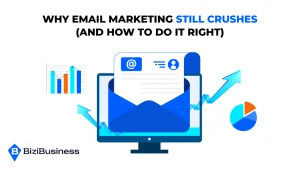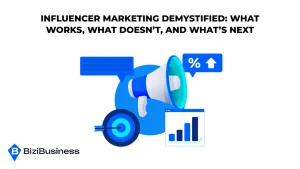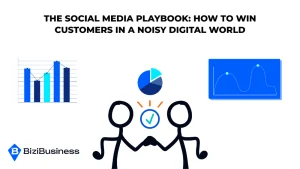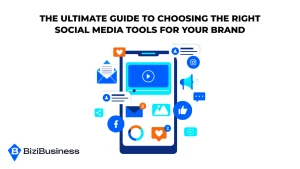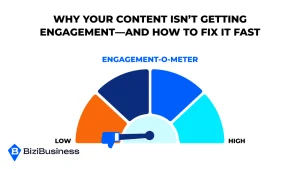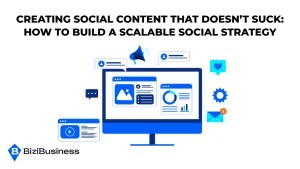BiziTopics
Not Just Likes—Leads: How Smart Brands Use Paid Social to Drive Real Results
BiziBusiness
Jul 8, 2025
10 min read
You’ve launched a campaign. The likes are rolling in. Follows are climbing. Maybe even a few shares.
But here’s the real question:
Are you making money from it?
Too often, businesses fall into the trap of chasing surface-level engagement. The dopamine hit from a viral reel or a popular post feels good—but if those interactions aren’t converting into leads, sales, or bookings, they’re not driving your business forward.
Vanity metrics can’t pay your bills.
They look nice on a report, but they don’t reflect ROI. And the truth is, platforms like Facebook, Instagram, and TikTok are engineered to reward content that entertains—not necessarily what sells. That’s why brands that only focus on content performance often burn through ad spend without seeing meaningful returns.
Smart brands know that real success is measured by conversions, not clicks. They use paid social as a high-performing engine that drives revenue, not just reach.
Because in today’s digital landscape, likes are a bonus—but leads are the goal.
In this article, we’ll unpack how you can make that shift—from flashy metrics to strategic, profitable ad campaigns that actually work. Whether you sell products or services, it’s time to stop playing for attention—and start building systems that convert.
The Mindset Shift: From Awareness to Acquisition

Most brands run paid ads the same way they post on social media: casually, inconsistently, and without a clear goal beyond “getting seen.”
But here’s the thing — visibility doesn’t equal viability.
To drive real results, smart brands treat paid social like a revenue-generating machine, not a popularity contest. That starts with a mindset shift: moving from awareness-only to a full-funnel acquisition strategy.
The Funnel Framework
Let’s break it down:
- Top of Funnel (TOFU): Get noticed — introduce your brand and spark interest
- Middle of Funnel (MOFU): Build trust — educate, demonstrate value, and nurture leads
- Bottom of Funnel (BOFU): Convert — drive actions like purchases or bookings
Most brands stop at the top. They boost a post, rack up impressions, and wonder why no one buys.
But smart brands move people through the funnel—with intentional targeting, tailored messaging, and offers that meet people where they are in the buyer journey.
Ecom vs. Service-Based: Different Journeys, Same Playbook
Here’s where the nuance comes in:
- Ecommerce buyers tend to move fast. The buying decision is often emotional and impulsive. Your ads need to make the value obvious and irresistible—fast.
- Service-based buyers need more nurturing. They want credibility, trust, and proof. Your ads should lead them to helpful content, testimonials, or consultations that reduce friction and build authority.
Same funnel, different fuel.
If you’re running ads without this strategy in place, you’re just throwing money into the wind. But when you align your campaigns with the funnel? You guide people from scroll to sale—on purpose.
Targeting That Actually Converts

You can have stunning ad creative, a killer offer, and the best landing page in your niche—but if you’re talking to the wrong people, you won’t see a dime.
This is where most paid social campaigns fall apart. They rely on vague targeting like broad interests, generic demographics, or worse… everyone aged 18–65+ in the U.S.
Smart targeting isn’t about reach. It’s about relevance.
Precision Over Popularity
To get real results, your targeting needs to go deeper:
- Interest & Behavior-Based Audiences: Think beyond surface-level categories. Target based on real actions (e.g., online shoppers, business decision-makers, recent app downloads).
- Custom Audiences: Upload your customer list, email subs, or past clients. Retarget people already familiar with your brand.
- Lookalike Audiences: Use your best-performing audience (buyers, leads) to build new segments that mimic their traits.
- Engagement-Based Retargeting: Target people who watched 75% of a video, clicked but didn’t convert, or abandoned checkout.
This turns your ad spend into a scalpel, not a shotgun.
Why This Matters
Without granular targeting, you’re paying to reach people who won’t convert.
With it? You’re placing your offer in front of people already primed to say yes.
And that’s how brands—both product-based and service-driven—run efficient, profitable campaigns that don’t just burn budget… they bring home results.
Creative That Stops the Scroll
You’ve zeroed in on the right audience. Now comes the challenge:
How do you make them stop, pay attention, and click?
In a world where people scroll faster than they read, your creative needs to do one thing: break the pattern. It has to interrupt the feed, hold attention for more than a second, and spark immediate interest.
But here’s the twist—it’s not about being flashy. It’s about being relevant.
What Makes Paid Ad Creative Actually Work?
- Bold Visuals: Your creative should stand out at a glance. Use contrast, motion, and clarity. Faces and direct eye contact still work. So do bold headlines, clear typography, and movement in the first 1–2 seconds (if it’s a video).
- A Compelling Hook: You have milliseconds to get someone to care. Lead with a benefit, a pain point, or a bold statement. The first line matters more than the rest of the ad.
- Short, Punchy Copy: This is not the place for paragraphs. Say more with less. Think: “Finally, an easier way to [do X].” Or: “3 reasons this changes everything.”
- A Clear CTA (Call-to-Action): Want clicks? Tell them what to do. “Learn more,” “Grab yours now,” “Get the guide,” “Try it today”—make the next step obvious and action-oriented.
Formats That Capture Attention
There’s no single best format, but each has a role to play:
- Short-form Video: Great for demos, storytelling, or emotional connection. Prioritize the hook—first 3 seconds are everything.
- Static Images: Clean visuals with strong headlines still crush it. Keep them clear, bold, and benefits-first.
- Carousel Ads: Perfect for step-by-step visuals, feature breakdowns, or storytelling across multiple frames.
- GIFs/Animations: Subtle motion can catch the eye without overwhelming.
Whether you’re selling a product, promoting a service, or pushing a lead magnet, your creative is your first impression. Make it count.
Landing Pages & Offers That Close

Getting clicks is great. But clicks don’t pay the bills.
What happens after someone taps your ad matters just as much—if not more—than the ad itself. If your landing page doesn’t match the intent of the ad or fails to deliver what was promised, you’re not just losing a sale—you’re wasting your ad spend.
This is where too many brands drop the ball.
Match the Message, Match the Mindset
Your ad sets an expectation. The landing page should deliver on it immediately.
That means:
- The headline should mirror the ad’s hook or offer.
- The visual style and tone should feel consistent.
- The page should lead visitors directly toward one clear action—no distractions, no detours.
When there’s a mismatch (e.g., ad promotes a discount but the landing page makes people search for it), people bounce. Fast.
What Makes a Landing Page Convert?
Here’s the anatomy of a high-performing landing page:
- Clear, Benefit-Driven Headline: Reinforce the “why” of the offer.
- One Primary CTA: Whether it’s “Buy now,” “Book a call,” or “Download the guide,” it should be obvious and repeated throughout.
- Trust Signals: Think testimonials, reviews, logos, or social proof. It reduces hesitation.
- Minimal Distraction: Remove navigation menus or competing CTAs. The goal is focus.
- Speed + Mobile Optimization: If your page loads slow or looks bad on a phone, you’re done. Speed and responsiveness are non-negotiable.
Offer Alignment = Conversion Power
Even the best-designed page won’t convert if the offer isn’t compelling. Make sure:
- The value is clear and immediate (what do they get right now?)
- You reduce friction (e.g., short forms, clear pricing, or no-obligation trials)
- The next step feels easy and low-risk
Whether it’s a product checkout or a service consultation, your landing page should do one thing: close the gap between interest and action.
Optimization & Iteration
The biggest myth in paid social?
“Set it and forget it.”
Even great campaigns need tuning. Platforms shift, audiences evolve, and creative fatigue is real. If you’re not testing, tweaking, and improving, you’re leaving serious money on the table.
The brands that win with paid social aren’t always the ones with the biggest budgets—they’re the ones that iterate smarter and faster.
Metrics That Matter
Forget about chasing likes or impressions. Here’s what to focus on:
- CTR (Click-Through Rate): Are people actually interested enough to click?
- CPC (Cost Per Click): Are you getting attention affordably?
- Conversion Rate: Are those clicks turning into action?
- ROAS (Return on Ad Spend): Are your campaigns actually profitable?
- Frequency: How often your ads are shown to the same person (watch for fatigue).
- Cost Per Result (Lead, Purchase, etc.): The true cost of success.
Track these weekly. Not just for reporting—but to fuel smarter decisions.
Test Everything, But Test With Purpose
A/B testing isn’t about guessing. It’s about structured learning. Try variations of:
- Ad Creative: New images, videos, or hooks
- Ad Copy: Different angles, tones, or value props
- Targeting: Test new lookalikes, behaviors, or exclusions
- Landing Pages: Layouts, headlines, CTAs, or offers
Pro tip: Only test one major variable at a time. Otherwise, you won’t know what made the difference.
Scaling the Right Way
When something works, resist the urge to triple the budget overnight. Instead:
- Scale gradually (10–20% budget increases)
- Duplicate winning ad sets into new audiences
- Refresh creative before fatigue sets in
Paid social is a living system. It needs maintenance, feedback loops, and smart adjustments. Brands that treat it as an ongoing process—not a one-time play—are the ones that grow sustainably.
Paid Social That Powers Growth

Here’s the truth most agencies won’t tell you:
Paid ads aren’t the whole strategy—they’re the amplifier.
When done right, paid social accelerates what’s already working. It feeds your funnel, fuels your SEO, boosts email performance, and reinforces your brand message across every channel. It’s the accelerator pedal, not the engine.
How Paid Social Fits Into a Bigger Growth Strategy
- Feeds Your Funnel: Attracts cold traffic and warms it up fast with retargeting, nurturing, and lead capture.
- Boosts SEO Conversions: Paid ads can spotlight your best-performing landing pages, giving you real-time feedback on messaging and offers—fuel for better organic content.
- Validates Offers Quickly: You don’t need to wait months to see if something works. Paid social gives instant market feedback.
- Multiplies Retention: Stay visible post-purchase or post-inquiry with strategic retargeting and content ads.
- Strengthens Brand Recall: Repetition builds trust. Even if they don’t convert today, they’ll remember you tomorrow.
Why Smart Brands Go Omnichannel (And Still Use Paid Social)
It’s not SEO vs. ads. It’s SEO + paid + email + content + retargeting. It’s a system, not a silver bullet.
The question isn’t:
“Should I be running ads?”
It’s: “How do I make ads work with everything else I’m building?”
Because when your organic presence, paid campaigns, and content strategy are aligned?
That’s when real, sustainable growth happens.
From Scrolls to Sales—Your Move
The playbook’s in front of you.
You’ve seen how smart brands treat paid social: not as a gamble, but as a scalable, data-driven growth engine. Not a vanity project, but a pipeline builder.
It’s not about going viral.
It’s about going profitable.
Whether you’re selling products, booking services, or building authority—paid social can take you there. But only if you use it strategically. That means:
- Targeting the right people
- Speaking to real problems
- Delivering offers that convert
- And constantly optimizing
You don’t need more noise.
You need more results.
So here’s your move: Stop chasing likes. Start building leads.
Subscribe to Newsletter
Unlock your creativity and stay up to date on marketing tips
